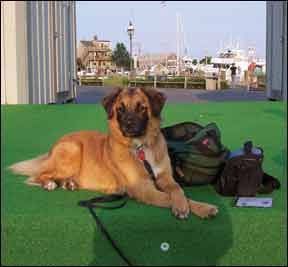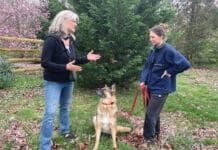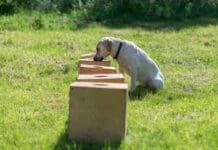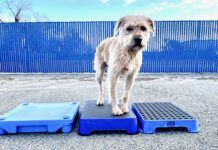How well do you really know your dog? Like most trainers and competitors, Nancy Tanner of Bozeman, Montana, assumed she knew hers inside out – until some whales and their trainers taught her an important lesson. You too can adopt the simple technique she learned at a marine mammal park to improve canine interactions at all levels.
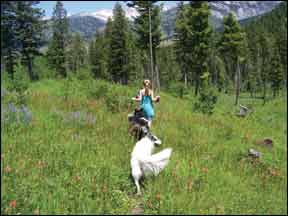
288
Tanner’s path of discovery began five years ago at Sea World in San Diego, California, where she took a behind-the-scenes tour.
“I chose ‘Lunch with the Orca Trainers,’ and it changed my whole approach to training,” she says. “In addition to enjoying great food, I got to watch the whales and ask questions. Sea World’s training program is impressive, but what they require from their trainers in knowledge, observation, and applied skills is even more so. I came away realizing that I might not know my dogs as well as I thought.”
What caught Tanner’s attention was the whales’ “free-time pool.” In this large, safe, comfortable environment, whales do whatever they like. Sometimes the pool is occupied by a single whale and sometimes by two or more. Trainers are always present but they never initiate activity. They simply watch and wait.
Occasionally the trainers add interactive objects such as beach balls, chunks of ice, or a bird kite on a tall pole. If a whale jumps for the kite the way orcas in the wild leap at low-flying birds, the trainer can acknowledge this with a whistle, but that is all. Shaping and luring are not allowed. If the whale initiates play, the trainer plays the whale’s game and does whatever that particular whale likes best, such as scratching his tongue, pouring water into his mouth, or throwing ice balls into his mouth. There are no food rewards. The free-time pool is used to build the trainer/animal bond but the two interact only if the whale wants to. The pool is never used for active training.
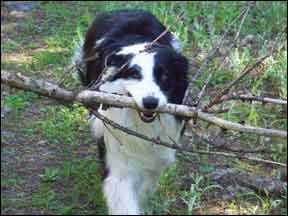
288
Tanner, who runs workshops and competes with her own dogs in agility and canine freestyle, thought for weeks about what free-time insights might contribute to her dog training. She started practicing what she calls “Observation Without Direction.”
“I wanted to come into my dogs’ world and learn by following their lead, not mine,” she says. “So I started to plan a free time routine by replicating, as much as possible, the whales’ free-time pool.”
This was at first a challenge because most of the areas she and her dogs visited were associated in some way with training. “I realized that my house, yard, and training field wouldn’t work for this project at all,” she says, “and what I had thought of as ‘free time’ while hiking actually involved working with my dogs the whole time.”
Tanner decided to look for an area she had never used for training. “It had to have boundaries for safety,” she says, “so that I would never have to call or correct them. No other dogs could be present except my own and no other people unless they were family. There could also not be any large distractions that would reward the dogs in a big way. Small self-rewards would be fine. In addition to being safe and free from distractions, it had to be a dog-friendly environment.”
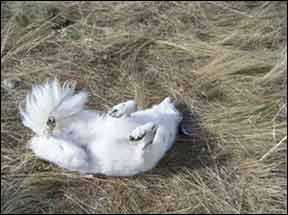
288
She chose a trail that has streams and trees with a steep drop on one side, a steep hill on the other, and a large meadow at the end.
“We go once or twice a week,” says Tanner. “I have no rules when we get out on this specific remote trail. The dogs can sniff, run, sit, follow, or do whatever they like. It’s up to them. I don’t bring food or toys. If they pick up a stick and initiate a game with me, I play fetch with the stick. If they play their I-am-going-to-lie-down-and-stalk-you hide-and-seek game, I will pop behind a tree and play. I initiate nothing. This free time is on their terms. We usually go for half an hour to two hours, depending on my day.”
What The Dogs Did
What did Tanner’s dogs show her, and how has Observation Without Direction changed their training?
“There is trust and relationship on both ends now,” she says. “When my dogs and I work, they are way more engaged. Our relationship isn’t just about what I want to do and the dogs doing learned behaviors. It’s about them taking part in my interests and me taking part in theirs. It is important to note that free time is not putting a dog in the backyard and then going inside to cook dinner. The trainer is working hard by observing and being attentive and intentional. There is a simple bit of magic to watching dogs and really being observant.”
Tanner’s dogs are very different from each other, and now their differences define her approach to training.
“Story is an amazing dog,” she says of her six-year-old Border Collie. “Honest and balanced is the best way to describe him. He enjoys dogs, people, work, play, and eating. He is a dog’s dog. What free time showed me was that he is inventive and all about ‘the game.’ He is always thinking up new games and keeping things light and fun. If he had a motto it would be, ‘Walk lightly and carry a big stick; fetch is way more fun that way.’”
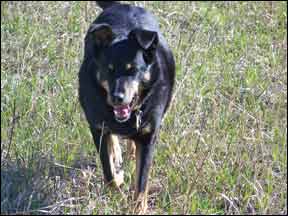
288
While Story has always been a willing partner, Tanner never felt that she was tapping into all of him. “He was almost too polite,” she says. “Through free time I observed that he liked to keep the party going. He was always inventing new games with either me or the other dogs. His self-reward is sharing his enthusiasm for games and including those around him. I have never observed him playing a game by himself. He always wants to include others. This was very cool for me as I knew how I could use this in training. Lightbulb!”
Tanner turned Story’s training into a big game, and this approach has made them partners in competition and in life. “There is no leader or owner. We come at it together. Whether it is freestyle, agility, hiking, or fun tricks, his pay-off is the interaction of the game. It also holds me accountable for being there 100 percent when I step out with him. There is no half way in anything we do together.”
Ocean, an eight-year-old Border Collie/Australian Shepherd, was a shy puppy. “At seven weeks,” says Tanner, “she was spooky and cautious. I worked for years building her confidence slowly but consistently through tricks, play with a purpose, agility, freestyle, and herding. Dog sports are where she shines because it is all work. Working became her safe place.
“Ocean is an amazing competition dog and loves to learn new things, but what I discovered through free time is that she did not have confidence outside of working. She did not want to explore or interact with the environment without my direction and was unsure of making choices on her own. It took her a year or two to leave me during free time, but once she started trying new things (digging, rolling in scat, exploring streams) all on her own, I saw another layer to my dog and watched her confidence grow. She is learning that choices are good, exploring can be wonderful, and if she needs to check in, I am always there.”
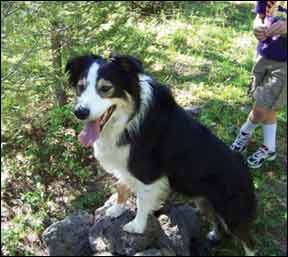
288
The first time Ocean felt comfortable enough to walk away from Tanner, she found elk scat and enjoyed herself immensely. She had never before shown any interest in scat, but after that experience, she sat taller and walked with all four paws solidly on the ground.
“This was a breakthrough for us,” says Tanner. “To this day she rolls in elk, deer, and coyote scat with gusto, and you cannot diminish her enthusiasm afterwards. While she will always have some cautiousness, she has more balance than ever before. In agility I let her decide whether she wants me close or needs more distance. In freestyle, if she renegotiates the path, we go with it. She is amazing and one of the most fun dogs to work with!”
Franny, an 11-year-old mixed breed, had low motivation for training and was never interested in human-directed activity. “Nothing got her involved,” says Tanner. “Tricks, agility, play with a purpose, fetch, tug, none of this was of interest to her, even in small spurts. She would patiently watch me go through my motions and slowly walk away. She showed zero interest even when I tried to hand her a steak.”
During free time, Tanner observed that Franny had stealth hunting skills, that her prey drive was alive and well, and her motivation was high. “She was focused and tenacious, so I brought this into her training. I would ask her for one small thing, maybe come to me in the house, and then say YES! and throw a meatball across the room. The reward of orienting, stalking, chasing, catching, and eating the meatball made a powerful impact on our training and relationship. I found a way to reach her through what she found highly rewarding. She is almost 12 now and still enjoys learning new things. I adore working with her.”
$eeker, a three-year-old Border Collie, has always lacked dog social skills and is more interested in people.
“In free time,” says Tanner, “I learned that $eeker is a mimic, and this caught me totally by surprise. He doesn’t just follow the lead of my other dogs, he copies what they are doing. I found this interesting because he lacks the ability to read canine social cues, so it was almost as if he was ‘trying’ through imitating. I noticed that if Ocean rolled in something, he did it next to her. If Story runs circles, he runs circles, too. If Franny was licking her paws, he would lick his paws, too. If Ocean marked, he would mark.
“I started bringing one of my other dogs when working with $eeker. For example, if I was chaining a complicated sequence, I would work with Ocean and then $eeker, and flip back and forth. He caught on faster this way than if I worked him by himself.”
Putting the Plan Into Action
As soon as she felt confident describing Observation Without Direction and the benefits of free-time training, Nancy Tanner began sharing her insights in workshops, online forums, and seminars. It didn’t take long for the technique to change canine lives.
Katie Tracanna lives in Dennis, Massachusetts, with six dogs. One of them, a six-year-old Shepherd/Border Collie named Wiley Coyote, competes with her in musical freestyle, trains for rally competition, makes therapy dog visits, and is an enthusiastic running partner.
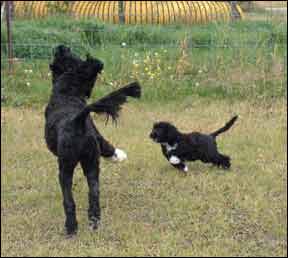
288
After she discovered Tanner’s ideas in an online workshop, Tracanna found a perfect free-time location at the beach. “You have to walk a ways to get to the spot,” she says, “but when you do, you’re surrounded by sea grass, sand, and the ocean. It’s a perfect place for free time with Wiley because I can see for a mile in all directions, so I don’t have to worry about anyone approaching when I want to just let him ‘be.’ And that’s what we do when we reach this spot. Wiley makes the rules. He can engage with me, swim, run the beach, and basically do whatever he wants for as long as we’re out there.
“Usually, he entertains himself for a few minutes and then starts engaging me in some sort of game, which could be chase, digging in the sand where I’m sitting, running around in a large circle, or a ‘bash brothers’ game where he likes to slam into me like a wrestler. We’ve modified these games to include in our training sessions as rewards, and they’ve helped build our bond because there are no limitations. It’s just us being in the moment together, cueing off each other and having fun.”
In Regina, Saskatchewan, Canada, retired dog judge Sue Ailsby has shared her life with Chihuahuas, Miniature Schnauzers, MinPins, Australian Cattle Dogs, Portuguese Water Dogs, and 17 generations of Giant Schnauzers. A trainer and competitor, her main interests are research, learning, teaching, bonding, and refining skills in service dog training, conformation, obedience, rally, agility, sled racing, scent hurdle racing, tracking, nose work, treiball, herding, carting, duck hunting, and tracking.
“I was taught as a child that the dog is my enemy,” she says, “and both his mind and body must be mastered. When I realized that the dog should be, at worst, a junior partner, it changed everything. Having a friend doesn’t mean imposing my own opinions on that friend, always doing what I want to do. If you’re going to be friends, you have to honor the other person’s opinions and let her choose. It’s the same with dogs. Giving the dog respected downtime hugely increases the bond and the dog’s desire and willingness to work for and with me.”
When she first read Tanner’s comments about the free-time pool, where the whales can do whatever they want and nothing is required of them, Ailsby says the idea hit her over the head like a sledgehammer.
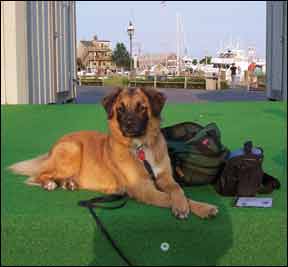
288
“It’s true that Scuba and Stitch, my Portuguese Water Dogs, can usually choose to interact with me, but I don’t usually choose to reciprocate. My dogs know that when I’m working on the computer, they might get a momentary tug or a ball-toss out of me, but after that I give them the ‘leave me alone, I’m working’ hand signal. When I’m talking on the phone, I’ll probably pet them, but not tug or toss. When I’m doing chores, they follow me around and get in my way, but all I’m doing with them is getting them out of my way without kicking them in the head. When I’m lying down, they can jump on the bed, but they have to lie down.
“I realized that I have no trouble being ‘present’ when training – training makes the whole rest of the world go away – but there was no time when I was in the dog’s world. That night Stitch and I went to the guest room in the basement to see what she would like to say to me when I’m actually listening.”
Now, says Ailsby, the dogs have faith that when they speak, she will listen. “This makes all training, as well as living with the dogs, easier because the dogs no longer think or behave as if they need to ‘shout’ at me to have me hear them. I recommend Observation Without Direction and free-time sessions to everyone who wants better, closer relationships with their dogs.”
Freelance writer CJ Puotinen lives in Montana, where she enjoys observing Chloe (her Labrador Retriever) and Seamus (her husband’s Cairn Terrier) in the great outdoors. She is the author of The Encyclopedia of Natural Pet Care and other books and a frequent contributor to WDJ.


